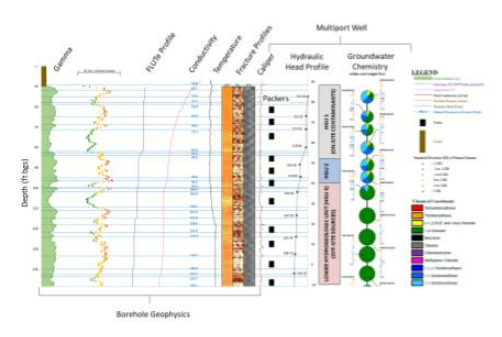Investigation design and analysis of hydrogeologic data at complex fractured bedrock site enabled identification of additional PRPs responsible for groundwater plumes beneath and downgradient of client’s manufacturing plant. Investigation findings provide a basis for remedial design, plume apportionment, and litigation strategy. Prepared a comprehensive Conceptual Site Model report and detailed expert rebuttal challenging the Plaintiff’s expert report.
Development of the CSM was based on integration of large dataset including chemical and hydraulic data from 1,100 wells (300 at depths 100-600 ft bgs), 19,800 soil samples from 9,000+ locations, multiport wells (19 to 24 ports/well), surface and borehole geophysics (110 borings), rock coring, and integration of on-site and off-site historical records. Bedrock aquifer is contaminated with DNAPL, VOCs, and 1,4-dioxane. The resulting conceptual site model includes multiple dipping hydrogeologic units (HGUs) offset by faults.
Contamination in soil, rock, and groundwater include the following chemicals:
- 1,1,1-Trichloroethane (TCA)
- 1,1-Dichloroethylene (1,1-DCE)
- 1,2-Dichloroethylene (1,2-DCE)
- 1,1-Dichloroethane (1,1-DCA)
- Tetrachloroethylene (PCE)
- Trichloroethylene (TCE)
- Cis-1,2-Dichloroethylene (cis-1,2-DCE)
- Vinyl Chloride (VC)
- Chlorobenzenes (monochlorobenzene and 1,2-dichlorobenzene)
- Emerging Contaminant: 1,4-dioxane
- Benzene
- Toluene



